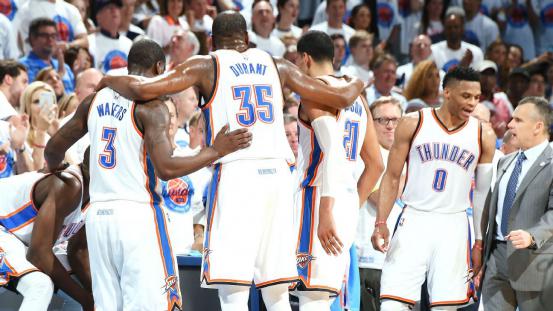- Commissioner’s statement on Ventura, Marte
- Ronnie O’Sullivan: Masters champion ‘felt so vulnerable’ in final
- Arron Fletcher Wins 2017 WSOP International Circuit Marrakech Main Event ($140,224)
- Smith challenges Warner to go big in India
- Moncada No. 1 on MLB Pipeline’s Top 10 2B Prospects list
- Braves land 2 on MLB Pipeline’s Top 10 2B Prospects list
- Kingery makes MLB Pipeline’s Top 10 2B Prospects list
- New Zealand wrap up 2-0 after Bangladesh implosion
- Mathews, Pradeep, Gunathilaka to return to Sri Lanka
- Elliott hopes for rain for Poli
How Thunder experimented all season to find winning formula
- Updated: May 26, 2016

10:35 AM ET
It had a perfect prize fight billing.
The Splash Brothers versus the Stache Brothers.
It was going to be the Golden State Warriors’ beaming radioactive lightshow against the Oklahoma City Thunder’s physical ground and pound.
The Thunder had just taken out the 67-win Spurs leaning heavily on a super-big lineup of Steven Adams and Enes Kanter. They were walking into a series against a whole new beast, the 73-win Warriors, who feature the famed “Death Lineup,” a grouping that is centerless and whose tallest player is 6-foot-7.
Big against small. Size against speed.
Until Billy Donovan turned that, and the series, on its head in Game 3. With 7:18 left in the first quarter, guard Dion Waiters headed for the scorers table to check in. Everyone in the building assumed Waiters was subbing for Andre Roberson, OKC’s offensively limited shooting guard whom the Warriors had resolved not to guard. Instead, Waiters checked in for Adams. The Thunder didn’t fear death; instead, they stared it in the face. And it has worked. The Thunder’s small lineup has outscored the Warriors 91-35 in 26 minutes over the past two games.
But the process of Donovan arriving at his small-ball lineup has been a long, often uncomfortable road. There were some grumbles in the locker room at times about his choices, mostly about closing lineups. He used the Kanter-Adams combo on opening night against the Spurs, and then didn’t go back to it for almost three months. He played small-ball early in the season, but stopped doing it around the All-Star break.
He said this after a loss in February to the Warriors: “But like for example, Golden State, they went small against us and I didn’t want to go small. I wanted to try and stay big to see what that looked like in playing in that game.”
The Thunder wanted to win that game, and every other game in the regular season. But Donovan wasn’t shaken by the anxiety of losing, instead viewing the 82 games as a lab for experimentation.
OKC’s small-ball lineup has given the Warriors fits in the Western …
continue reading in source espn.go.com
